Aerosol optical properties monitoring system
 Column Aerosol Optical Depth
Column Aerosol Optical Depth
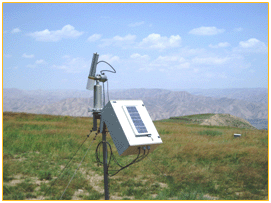
The observations of aerosol optical depth (AOD) are made using an automatic sun tracking photometer (CE318N-VPS8, Cimel) with 8 filters in the visible and near infrared at wavelengths of 440, 670, 870, 870,870, 936 and 1020 nm. The instrument calibration is carried out once per year. The total column water vapor, ozone and aerosols properties can be derived. It is also very useful to determine the atmospheric correction of satellite data. The graph (right) shows the daily AOD in SACOL.
 Aerosol Size Distribution
Aerosol Size Distribution

Aerosol vertical distribution (represented by extinction coefficient) is measured using a Micro-Pulse Lidar system (MPL-4, Sigma Space). The MPL has one measurement channel at 527 nm, that records backscatter signals up to 20+ km. From the relative backscatter profile, other data products are possible including multiple cloud decks, cloud and layer boundaries, as well as aerosol extinction and backscatter profiles. Aerosol vertical distribution is also measured by a CAMLTM Micro Lidar (CE 370-2, CIMEL & CNRS). It is a portable, eye safe and unattended backscattering lidar that features the ability to profile atmospheric cloud and aerosol structures. Such information is critical to operational field and lab applications related to meteorology and environment
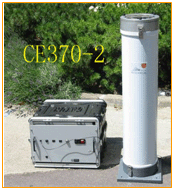

 Aerosol Vertical Distribution
Aerosol Vertical Distribution
Aerodynamic diameter as well as relative light-scattering intensity of aerosol particles that are between 0.5 and 20 μm in diameter are measured using an aerodynamic particle sizer (APS-3321, TSI).
 Aerosol Scattering Coefficient
Aerosol Scattering Coefficient
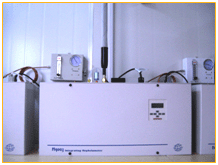
The observations of aerosol scattering coefficient are performed using three single wavelength Integrating Nephelometers(M9003, ECOTECH, 450, 550 or 700 nm, right), and a TSI three wavelengths (450, 550 and 700nm) Integrating Nephelometer (Model 3563, TSI, below). These two kinds of nephelometer share the same principle.
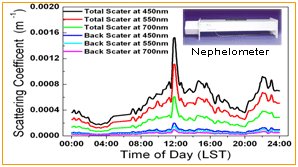
A TSI nephelometer is particularly well-suited for measurements related to climate, visibility, and air quality. The graph (right) shows the daily change of the mean Scatter Coefficients over Xigu District in Lanzhou City (Zhang et al, 2004), which is consistent with the change of concentration of PM10.
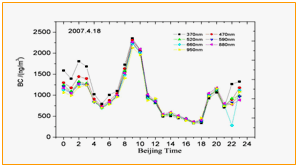
 Aerosol Absorption Coefficient
Aerosol Absorption Coefficient
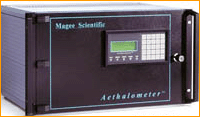
The aerosol light-absorption properties are measured at seven wavelengths (370, 470, 520, 590, 660, 880 and 950 nm) by an aethalometer (Model AE-31, Magee Sci.). The primary propose of this instrument is to measure the aerosol black carbon (BC) concentration in the atmosphere.
 English
>
Site Profile
>
Experiment Instruments
>
Content
Experiment Instruments
English
>
Site Profile
>
Experiment Instruments
>
Content
Experiment Instruments